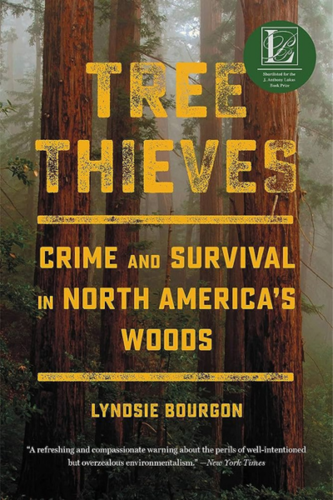31 July 2023

“After the tree was felled, poachers entered the park and sawed the trunk (or “bucked’ it) into portable pieces, leaving a trail of sawdust and abandoned equipment behind.”
This isn’t a description of tree-poaching in the Amazon, or the rainforests of Central Africa or South East Asia, but in British Columbia.
Lyndsie Bourgon has written a fascinating account of illegal logging in the ancient woodlands of North West America, with some trees being more than 2,000 years old, where tree and forest conservation intersect with industrial and community decline, as well as poverty, drug addiction and crime. Although the book does cover illegal logging in the Amazon jungle of Peru, it is primarily focussed on the challenges faced by law enforcement in North West USA and in British Columbia to combat illegal logging, as well as those of the timber-industry communities established since the late 19th century to maintain meaningful and financially viable lives.
From Ms. Bourgon’s investigations, there are many parallels between the illegal logging and the illegal wildlife trading industries – individuals looking to generate an income to support themselves and their families in areas where meaningful and well-paid employment is limited or unavailable; demand for unique products from businesses/ wealthy individuals willing to pay the requisite prices, whilst not asking from where or how the products were sourced; an unscrupulous supply chain, often involving organised crime; under-resourced law enforcement agencies at all stages of the process, from source to end-user, to apprehend and convict the perpetrators at various stages in the supply chain.
What I found most interesting in the book was that the US’ Fish & Wildlife Forensic Laboratory, in the state of Oregon, has developed technology to analyse timber DNA to identify individual trees and, hence, their original location. They are establishing a tree DNA database for north-western America that local law enforcement can use to identify the origin of timber suspected of being illegally sourced, particularly if it has been poached from public lands. In collaboration with scientists across the Pacific Northwest, the database is being expanded to cover thousands of samples from trees of the same species across their entire biome. The development and expansion of this database, hopefully, across the globe, should send a warning to sawmill owners and the manufacturers of all high-value wood-based products, eg. furniture, musical instruments, etc., that law enforcement agencies now have a powerful tool to check the origin of the wood they use in their end products.
Why should illegal logging be of concern to us? Firstly, the United Nations and Interpol estimate the worldwide value of this industry to be worth between $51bn and 157bn annually, significantly ahead of illegal mining and waste disposal, the other major environmental crimes the world faces. Secondly, when considered as part of global deforestation, according to Interpol, it contributes 17% of all man-made emissions, a significant driver of climate change. At COP26, in November 2021, the leaders of more than 100 countries, committed to halt deforestation by 2030, whilst 30 financial institutions agreed to eliminate the harmful practice from their portfolios by 2025. Now, nearly two years on, how far have the various governments and financial institutions progressed in their, then, stated objectives?
Addressing deforestation and illegal logging, in particular, will not be easy, as shown by Lyndsie Bourgon’s book. The many issues, particularly social ones, that need to be addressed require investment and education, and involvement of the communities concerned, to protect and manage the forests that surround them and on which their livelihoods depend. Governments, law enforcement agencies and the organisations that support the timber trade, from source to end-customer, such as logistics businesses, insurance brokers and underwriters, and banks, should consider where they can make a positive impact to significantly reduce illegal logging. As with so many of the financial and environmental crimes that the global community faces today, a whole system response is required to effect the required changes.